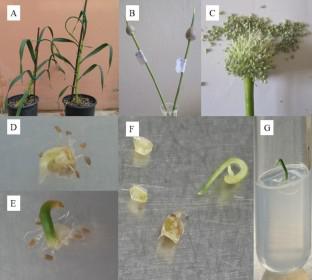In Vitro Cellular & Developmental Biology - Plant ( IF 2.6 ) Pub Date : 2023-08-07 , DOI: 10.1007/s11627-023-10356-2 Fevziye Celebi-Toprak , Zeynep Ergun , Ali Ramazan Alan

|
Allium tuncelianum (Kollman) Özhatay, Matthew and Şiraneci forms a single-cloved edible white bulb with a mild garlic (A. sativum) odor and taste. Its ability to form seeds makes it suitable for genetic improvement via classical and modern approaches. A detailed study was carried out to determine the gynogenic and somatic plant regeneration potential of two A. tuncelianum accessions (AT1 and AT2). Unopened flower buds of A. tuncelianum accessions were cultured in various BDS (Dunstan and Short, Physiol Plant 41:70-72, 1977) and MS (Murashige and Skoog, Plant Physiol 15:473-497, 1962)-based induction media. Accessions showed slight differences in their responses to gynogenesis and somatic shoot induction cultures. Gynogenic plantlets were obtained in six induction media (T2, T3, T6, T9, T12, and T15). Three of these (T2, T3, and T9) did not contain plant growth regulators (PGRs). Seventeen (0.09%) gynogenic plantlets were obtained from approximately 20,000 AT1 and AT2 flower buds used in gynogenesis induction experiments. The highest gynogenic plantlet production frequency (0.34%) in AT1 was achieved with buds cultured in T12 [MS-based medium with 1.0 mg L−1 α-naphthalene acetic acid, 8.0 mg L−1 isopentenyl adenine, and 100.0 g L−1 sucrose]. Flower buds of AT2 showed the best gynogenic response (0.44%) in T2 (PGR-free BDS–based medium with 50.0 g l−1 sucrose). Somatic regeneration was observed in six media (T5, T6, T11, T12, T14, and T15) containing at least 50.0 g L−1 sucrose and auxin- and cytokinin-type PGRs. Two hundred and thirty-three (1.18%) somatic plantlets were obtained from the cultured flower buds of AT1 and AT2. The highest somatic plantlet production frequencies for AT1 (4.44%) and AT2 (3.89%) were obtained from flower buds cultured in T5 [BDS-based medium with 2.0 mg L−1 2,4-dichlorophenoxyacetic acid, 2.0 mg L−1 6-benzylaminopurine, and 50.0 g L−1 sucrose]. Three induction media (T6, T12, and T15) provided both gynogenic and somatic regeneration in A. tuncelianum. Eight of 17 (46.06%) gynogenic plantlets and 33 of 233 (14.16%) somatic plantlets continued to grow, resulting in healthy plants with green leaves and well-established root systems. The remaining gynogenic plantlets had abnormal development. Flow cytometric analysis of the well-developed gynogenic plants showed that two were haploid (25%), four were diploid (50%), and two were mixoploid (25%) containing both haploid and diploid cells. The nine abnormal gynogenic plantlets were diploid. Results obtained from this study suggest that doubled haploid technology can be used in the production of homozygous A. tuncelianum inbred lines in breeding programs.
中文翻译:

通过体外雌核发育生产 Allium tuncelianum (Kollman) Özhatay、Matthew 和 Şiraneci 的单倍体和双单倍体植物
Allium tuncelianum (Kollman) Özhatay、Matthew 和 Şiraneci 形成单瓣的可食用白色球茎,具有温和的大蒜 ( A. sativum ) 气味和味道。它形成种子的能力使其适合通过经典和现代方法进行遗传改良。进行了一项详细的研究,以确定两种A. tuncelianum种质(AT1 和 AT2)的雌核和体细胞植物再生潜力。A. tuncelianum未开放的花蕾种质在各种基于BDS(Dunstan和Short,Physiol Plant 41:70-72,1977)和MS(Murashige和Skoog,Plant Physiol 15:473-497,1962)的诱导培养基中培养。种质对雌核发生和体细胞芽诱导培养物的反应表现出轻微差异。在六种诱导培养基(T2、T3、T6、T9、T12 和 T15)中获得雌核植株。其中三种(T2、T3 和 T9)不含植物生长调节剂 (PGR)。从用于雌核发育诱导实验的大约 20,000 个 AT1 和 AT2 花蕾中获得了 17 个(0.09%)雌核幼苗。AT1 中最高的雌核植株生产频率 (0.34%) 是在 T12 中培养的芽实现的 [基于 MS 的培养基,含有 1.0 mg L -1 α-萘乙酸,8.0 mg L -1异戊烯基腺嘌呤和100.0g L -1蔗糖]。AT2的花蕾在T2(不含PGR的BDS培养基,含有50.0 g l -1蔗糖)中表现出最佳的雌性反应(0.44%)。在含有至少 50.0 g L -1蔗糖以及生长素和细胞分裂素型 PGR 的六种培养基(T5、T6、T11、T12、T14 和 T15)中观察到体细胞再生。从AT1和AT2培养的花蕾中获得233个(1.18%)体细胞试管苗。AT1 (4.44%) 和 AT2 (3.89%) 的最高体细胞植株生产频率是从在 T5 [基于 BDS 的培养基,含有 2.0 mg L -1 2,4-二氯苯氧基乙酸,2.0 mg L -1 6 ] 中培养的花蕾中获得的。-苄氨基嘌呤,和 50.0 g L -1蔗糖]。三种诱导培养基(T6、T12 和 T15)在A. tuncelianum中提供了雌核再生和体细胞再生。17 个雌核试管苗中的 8 个(46.06%)和 233 个体细胞试管苗中的 33 个(14.16%)继续生长,形成具有绿叶和完善根系的健康植物。剩余的雌核植株发育异常。对发育良好的雌核植物的流式细胞术分析表明,其中两个是单倍体(25%),四个是二倍体(50%),两个是同时包含单倍体和二倍体细胞的混合倍体(25%)。九个异常雌核植株是二倍体。本研究获得的结果表明,双单倍体技术可用于育种计划中纯合A. tuncelianum自交系的生产。



























 京公网安备 11010802027423号
京公网安备 11010802027423号